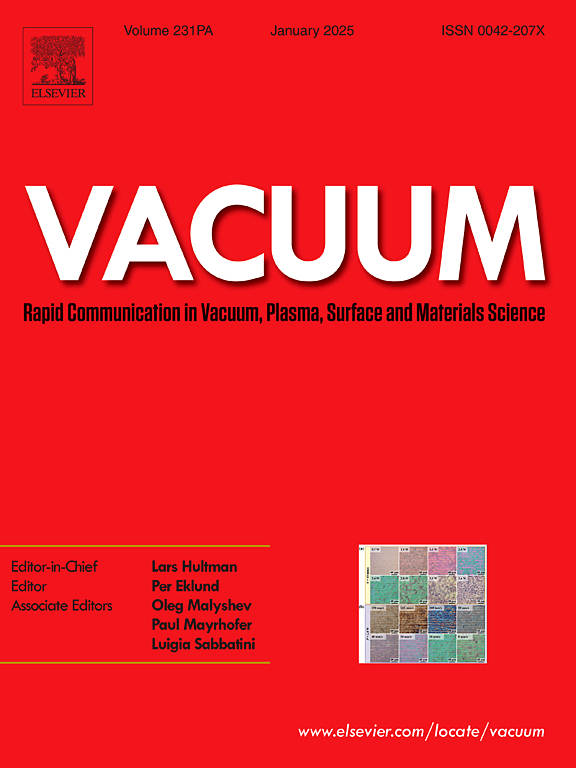Mo vacancies enhancing Pt, Ni co-incorporated Mo2C nanofibers for high-efficiency water decomposition
IF 3.8
2区 材料科学
Q2 MATERIALS SCIENCE, MULTIDISCIPLINARY
引用次数: 0
Abstract
Hard alloy type compounds are promising candidates for developing robust and cost-effective electrocatalysts due to the good conductivity and lattice hardness. However, their insufficient intrinsic activities require further surface modification, which remains a significant challenge due to the high hardness and surface inertness. Herein, a vacancies-promoted heteroatoms integration method is provided to construct Pt and Ni co-incorporated molybdenum carbide nanofibers ((Pt, Ni)-Mo2C). The Pt and Ni atoms filling into the Mo vacancy reduce the formation energy by ∼5.5 eV, which indicates an improved crystal stability. The electrons flow from Mo, Ni centers to Pt, C centers, resulting in the shifted average valence of Mo, Ni sites and moderate oxidation states of Pt, C sites. Therefore, the hydrogen adsorption free energy (ΔG∗H) of Mo and C sites increases from ∼-0.6 eV to ∼-0.03 eV (C sites) and ∼-0.2 eV (Mo sites), resulting in a state closer to ideal state (0 eV). As a result, the (Pt, Ni)-Mo2C catalyst exhibits an excellent overpotential of 64 mV at 10 mA cm−2 for hydrogen evolution reaction (HER), reducing by 149 mV than pure Mo2C. Current work paves a favorable method for integrating dissimilar atoms to modify hard alloy type compound surface.
钼空位增强铂、镍共掺Mo2C纳米纤维的高效水分解性能
硬质合金型化合物具有良好的导电性和晶格硬度,是开发坚固耐用且经济高效的电催化剂的理想候选材料。然而,由于硬度和表面惰性较高,它们的内在活性不足,需要进一步的表面改性,而这仍然是一个巨大的挑战。本文提供了一种空位促进杂原子整合的方法来构建铂和镍共嵌碳化钼纳米纤维((Pt, Ni)-Mo2C)。填充到 Mo 空位中的铂原子和镍原子使形成能降低了 5.5 eV,从而提高了晶体的稳定性。电子从 Mo、Ni 中心流向 Pt、C 中心,导致 Mo、Ni 位点的平均价态偏移和 Pt、C 位点的中等氧化态。因此,Mo 和 C 位点的氢吸附自由能(ΔG∗H)从 ∼-0.6 eV 增加到 ∼-0.03 eV(C 位点)和 ∼-0.2 eV(Mo 位点),从而更接近理想状态(0 eV)。因此,(Pt, Ni)-Mo2C 催化剂在 10 mA cm-2 氢进化反应(HER)中表现出 64 mV 的优异过电位,比纯 Mo2C 减少了 149 mV。目前的工作为整合不同原子以改性硬质合金型化合物表面铺平了道路。
本文章由计算机程序翻译,如有差异,请以英文原文为准。
求助全文
约1分钟内获得全文
求助全文
来源期刊

Vacuum
工程技术-材料科学:综合
CiteScore
6.80
自引率
17.50%
发文量
0
审稿时长
34 days
期刊介绍:
Vacuum is an international rapid publications journal with a focus on short communication. All papers are peer-reviewed, with the review process for short communication geared towards very fast turnaround times. The journal also published full research papers, thematic issues and selected papers from leading conferences.
A report in Vacuum should represent a major advance in an area that involves a controlled environment at pressures of one atmosphere or below.
The scope of the journal includes:
1. Vacuum; original developments in vacuum pumping and instrumentation, vacuum measurement, vacuum gas dynamics, gas-surface interactions, surface treatment for UHV applications and low outgassing, vacuum melting, sintering, and vacuum metrology. Technology and solutions for large-scale facilities (e.g., particle accelerators and fusion devices). New instrumentation ( e.g., detectors and electron microscopes).
2. Plasma science; advances in PVD, CVD, plasma-assisted CVD, ion sources, deposition processes and analysis.
3. Surface science; surface engineering, surface chemistry, surface analysis, crystal growth, ion-surface interactions and etching, nanometer-scale processing, surface modification.
4. Materials science; novel functional or structural materials. Metals, ceramics, and polymers. Experiments, simulations, and modelling for understanding structure-property relationships. Thin films and coatings. Nanostructures and ion implantation.
 求助内容:
求助内容: 应助结果提醒方式:
应助结果提醒方式:


